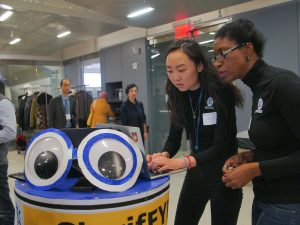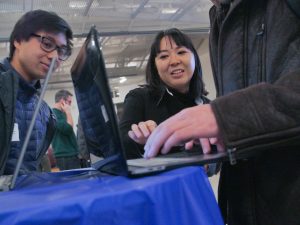Columbia’s First Boot Camp Learners Show Off Their Teamwork and Tech Skills at Demo Day

Learning how to code is one thing. But putting it to practice by developing your own project is a whole other ballgame. Project-based learning is proven to be one of the most effective ways to hone your coding skills, develop an aptitude for teamwork and collaboration, and build up a stellar portfolio.
That’s why each learner in our partner boot camps is required to create three projects—and then show off their best work at a course-culminating Demo Day, open to employers and professionals in the local community.
Over countless final days of class and demo day events, we’ve been impressed with the creativity and work ethic of the learners in our university partner Boot Camps. The first class of successful learners of the Columbia Engineering Coding Boot Camp in New York City was no exception. Over the 24-week, part-time Boot Camp, these learners used their personal experiences, their unique passions, and their new high-demand coding skills to inspire their projects, to great results.
Here are three of the projects that really wowed us.
Ghislaine Georges and Silu Hu: The dynamic duo behind ClarifEYE

Photo credit: Abby Lee
Technology has the power to help people. That’s the idea that inspired Ghislaine Georges and Silu Hu to create ClarifEYE, a mobile app to help blind people safely navigate bustling city streets.
“We wanted to do something purposeful—something we were both interested in, but that would be useful and help people,” Ghislaine said. “We were brainstorming and this was a project we just kept coming back to.”
It was an idea that would be a challenge to complete, but they were committed. To pull this off, the all-female team would need to teach themselves an entirely new language, React Native. “We knew it would be challenging but we weren’t deterred,” Ghislaine emphasized.
Using their baseline knowledge of React from boot camp, Ghislaine and Silu taught themselves the new code, leaning on the tutors and instructors for help. “The instructors gave us the confidence we needed to look for the information we needed,” Ghislaine said. Added Silu, “My tutor helped me a lot as well. She was awesome—all of the resources Trilogy provided were just really amazing.”
Come Demo Day, the two coders were ready, but nervous. “We weren’t sure if people would be interested,” Ghislaine said. “But once we demonstrated the app, the reactions were great. We were really encouraged, especially as the only female-only team.”
Demo Day helped Ghislaine and Silu realize ways to improve their app—and they’ve been going full-speed ahead ever since.
“We’re not satisfied with where the app is yet. We’re digging into AI to make it more user-friendly,” Silu said. “We got a ton of knowledge in a really short amount of time. But we need to keep practicing and just keep learning. The final day of boot camp is not the end of our education.”
Alicia Chan and Luis Rishi Puno: The problem-solving collaborators behind Hagg

Photo credit: Abby Lee
Like many who decide to enroll in coding boot camps, Alicia Chan and Luis Rishi Puno wanted a change. Not feeling challenged in their careers, and seeing demand for skilled web developers in NYC at an all-time high, the two decided to embark on a new journey at the Columbia Coding Boot Camp.
When it came time to decide on a final project, Luis thought back to his recent trip to Nepal, where all commerce is based on haggling. “People could smell blood and take advantage of you unless you knew the average price of a product,” Luis said. “I thought it would be a cool idea if we could crowdsource prices to help with purchasing.”
Coming from the fashion industry, Alicia was sold on the idea. “It does serve a lot of opportunities for growth. The main idea can expand in many ways and be really good for niche industries,” she said.
During the first meeting, the duo went through one another’s strengths and weaknesses, figuring out how to work together and how to divvy up the project. With her background in fashion, Alicia took the front-end design, while Luis worked on the user story and full stack.
But development wasn’t a piece of cake: they had to work through a lot of obstacles. “We had to pull and push code and sometimes people aren’t on the same page,” Luis said. “But it was a really good learning experience. We all learned a lot and I was really impressed with the improvement.”
The biggest takeaway was learning how to code as a team. “In reality, one person can’t build an app. It’s not like math where there’s just one way to build a solution,” Alicia said. “Teamwork isn’t just about communicating. I was able to learn so much more, not even just asking or talking to Luis but by just looking at his code and incorporating my ideas.”
What’s next for the two coders? Improving the app. “Our app isn’t close to complete, but what we did and what I’m happy with is that we showed this proof concept,” Luis said. “Right now we’re talking every day about how to improve the app and make it usable.”
Adam Chernick: The tech-savvy designer behind ManagAR
 Unlike Hagg, ManagAR wasn’t borne out of the desire for a career change, but rather was devised as a helpful career tool. As an associate at an architecture firm, Adam Chernick was going down a technology-focused path when he quickly realized he needed to upskill. “You kind of hit a threshold where you have to start creating custom tools,” he said. “So I knew I had to get better at writing code.”
Unlike Hagg, ManagAR wasn’t borne out of the desire for a career change, but rather was devised as a helpful career tool. As an associate at an architecture firm, Adam Chernick was going down a technology-focused path when he quickly realized he needed to upskill. “You kind of hit a threshold where you have to start creating custom tools,” he said. “So I knew I had to get better at writing code.”
Eager to advance in his career, Adam enrolled in the boot camp to learn crucial full stack skills. When it came time to develop his own project, the idea came easily: an AR project management tool for architecture firms.
“Apps like this already exist but they’re very expensive and rigid. They’re not customizable,” Adam said. “I wanted to build my own that was similar in concept, but more flexible. There’s a need in the market for this type of tool.”
The idea was easy; execution was another story. To make the app come to life, Adam needed to put two parts in motion: mobile and web. On top of that, Adam was working solo.
But he wasn’t without help—the instructors and TAs were always there to lend a hand. “Jordan [the instructor] was amazing. He was there with me until midnight 3 times and he really helped me get the project done,” Adam said.
When it came time to present ManagAR, Adam was pleased with the feedback he received—and the connections he made. “I’ve actually been meeting with people from Demo Day and it’s been great to continue to talk about interesting topics in the industry,” Adam said.
As for the future of his project? “I believe this will be able to tie into other immersive tools, and I plan to continue to build out this project. There’s a need for this type of tool, and we’re solving an important problem,” Adam said.

 Live Chat
Live Chat